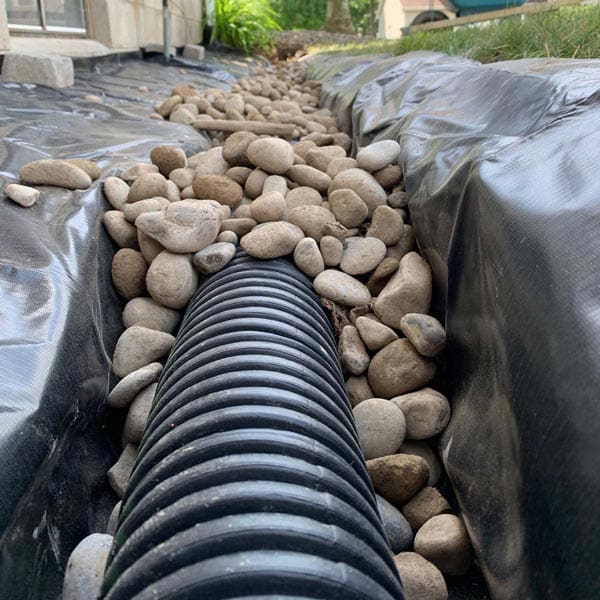Understanding the Relevance of a Sewage-disposal Tank French Drainpipe for Effective Wastewater Administration
The integration of a septic container French drainpipe system plays a pivotal function in effective wastewater monitoring, yet its importance is commonly ignored. Comprehending the mechanics and advantages of such a system can brighten its crucial function in stopping soil saturation and boosting groundwater high quality.
What Is a Sewage-disposal Tank French Drain?
A sewage-disposal tank French drain is a specialized drainage system created to manage wastewater and protect against flooding in locations where traditional drainage methods might be inadequate. This system integrates the functionalities of a traditional sewage-disposal tank with a French drain, permitting efficient wastewater treatment and effective water diversion.

Built making use of perforated pipelines stocked crushed rock trenches, a French drainpipe facilitates the movement of water away from crucial areas. It enables for the infiltration of excess water into the bordering soil, promoting effective drain while securing the septic tank's stability. The combination of these two systems is specifically valuable in areas with hefty rains or bad drain, ensuring the durability and functionality of wastewater management systems while guarding public health and the environment.

Exactly How It Works in Wastewater Administration
In wastewater monitoring, the integration of a septic system and French drain plays a vital role in guaranteeing effective treatment and disposal of sewage. The septic system serves as the very first line of defense, where wastewater undertakes initial therapy via sedimentation and anaerobic food digestion. Solids resolve at the bottom, creating sludge, while lighter products, such as grease and oils, float to the top, developing a residue layer. This procedure decreases the natural lots of the wastewater prior to it moves forward.
As soon as the wastewater is cleared up, it flows right into the French drain system, which is made to promote additional treatment and safe dispersal. The French drainpipe includes perforated pipes buried in crushed rock or stone, permitting treated effluent to percolate into the bordering soil. This all-natural purification procedure help in the elimination of nutrients and microorganisms, advertising groundwater recharge and minimizing the danger of surface area contamination.
With each other, the septic system and French drainpipe create a lasting technique to wastewater management, lessening environmental influence while guaranteeing conformity with health and wellness regulations. This incorporated system not just safeguards public health and wellness but likewise keeps the stability of regional ecosystems.
Benefits of a French Drain System

The French drain system uses numerous advantages that enhance both wastewater administration and ecological security. Largely, it successfully redirects water away from essential areas, lowering the danger of flooding and soil saturation that can jeopardize septic systems. This positive drain service aids maintain the stability of the sewage-disposal tank by protecting against excess wetness, which can lead to system failure.
Additionally, an effectively installed French drainpipe decreases the capacity for groundwater contamination. By channeling wastewater away from the property, it decreases the likelihood of contaminants going into neighborhood water resources, thus securing public health and wellness and maintaining environmental balance. The system likewise enhances the aesthetic appeals and performance of exterior rooms by stopping water accumulation, which can produce sloppy locations or undesirable puddles.
Additionally, French drains pipes call for reasonably reduced maintenance compared to various other drain remedies, making them an economical lasting investment. Their adaptability permits them to be made use of in numerous landscapes, accommodating both business and property buildings. Ultimately, the benefits of a French drainpipe system expand past prompt water drainage demands, over at this website adding to sustainable wastewater administration methods and promoting ecological stewardship.
Common Concerns Without a French Drainpipe
Overlooking the installation of a French drain can cause considerable challenges in taking care of water flow and keeping dirt integrity. One of the main issues is the buildup of excess surface area water, which can develop swamping or pooling in yards, specifically after hefty rainfall. This stagnancy can saturate the dirt, causing erosion and jeopardizing the structure of nearby frameworks.
Furthermore, without a French drain, groundwater can incorrectly penetrate septic tanks, raising the danger of system failing. The resulting backup can bring about undesirable smells, health and wellness hazards, and expensive repair services. Poor drainage can likewise promote the growth of mold and mold, which can adversely affect indoor air high quality and pose health and wellness risks to occupants.
Furthermore, the lack of a proper drainage system might encourage the expansion of bugs and parasites, attracted to standing water. Plants might struggle to prosper due to changing moisture levels, causing an unclean landscape. Ultimately, the lack of a French drain can lead to a variety of structural and environmental concerns that demand significant treatment and expense to remedy. Consequently, applying a French drain system is vital for efficient wastewater management and building protection.
Upkeep Tips for Homeowners
Routine maintenance of a French drainpipe is necessary to ensure its ideal performance and longevity. If sediment is present, consider making use of a high-pressure water jet to remove the drain.
Additionally, it is critical to keep the area around the French drainpipe without debris, such as leaves, dirt, and other raw material. This will avoid clogging and enable effective water drainage. Routinely cutting plants and planting far from the drain can additionally reduce origin intrusion.
Furthermore, home owners ought to check the efficiency of their French drain after hefty rains. Observing how well water is directed far from the septic system can supply insights right into its functionality. It might show my latest blog post a demand for professional evaluation. if merging water is noted.
Last but not least, consider scheduling regular professional inspections to assess the total condition of original site the drainpipe. Such proactive actions will assist keep the efficiency of your French drain and make sure reliable wastewater management for several years to come.
Final Thought
In conclusion, the septic storage tank French drain system plays a vital role in efficient wastewater administration by making sure appropriate treatment of sewer and reliable water diversion. On the whole, the septic container French drain represents a sustainable solution that profits both property and commercial homes across numerous landscapes.
The assimilation of a septic container French drain system plays a crucial role in reliable wastewater administration, yet its value is commonly ignored. Ultimately, the advantages of a French drainpipe system extend past instant water drainage requirements, adding to sustainable wastewater management practices and advertising ecological stewardship.
Furthermore, without a French drainpipe, groundwater can improperly infiltrate septic systems, enhancing the threat of system failure - French Drain System. Applying a French drainpipe system is important for reliable wastewater management and home security
In verdict, the septic tank French drain system plays an important function in efficient wastewater management by guaranteeing correct therapy of sewer and efficient water diversion.